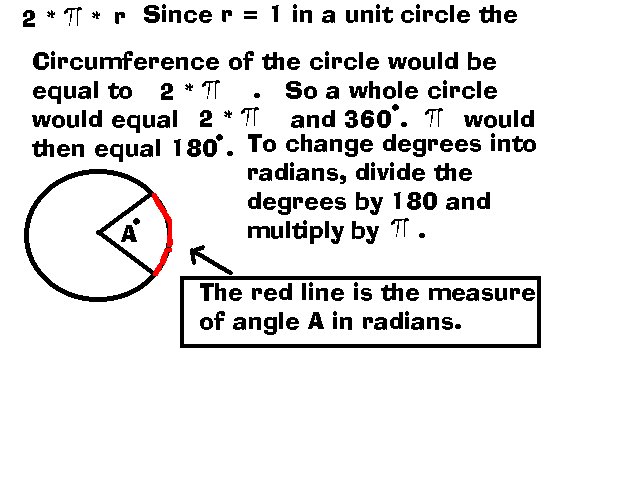

If so instructed by your teacher, print out a worksheet page for these problems.
Background:
Visit the Glider Trajectory Problem and the Vector Balance of Forces for a Glider. Study the equation: L/D = 1/a where L stands for lift, approximately equals the weight of the glider, and is measured in newtons; D stands for the drag on the glider and is measured in newtons; and a stands for glide angle and is measured in radians.Weight and mass are related. Weight is equal to mass times gravity: Fw = m * g where Fw stands for weight and is measured in newtons (Note: W is also used as a symbol for weight.), m stands for mass and is measured in kilograms, and g stands for gravity and is equal to 9.8 m/s2.
Radian measure is another way of measuring the size of an angle. When we measure an angle in radians we are measuring the length of the arc the angle cuts out of a unit circle. A unit circle has a radius of one unit; therefore, the circumference of a unit circle is equal to 2 times pi.
Problems:
Create a spreadsheet that finds the weight of each glider, the measure of each angle in degrees, and the drag on each glider at angles of 2, 3, 4, and 5 degrees.
Model Gliders Mass Full-sized Gliders Mass 1 .5 kg 4 500 kg 2 .9 kg 5 900 kg 3 1.4 kg 6 1,400 kg
Questions:
- Compare the drag
between model glider 1 and the full-sized glider 4 for all four angles.
What conclusion can you draw?
- Based on your answer
in Question 1, would it be valid to use a model glider to study the
drag on a full-sized glider?
- What is the relationship between glide angle and drag?
HOME
EDUCATOR RESOURCES | AERONAUTIC EDUCATIONAL RESOURCES | INTERNET ACCESS RESEARCH | ICING RESEARCH TUNNEL
BEGINNER'S GUIDE TO AERONAUTICS | FREE SOFTWARE | AERODYNAMICS INFORMATION | AERODYNAMICS PROBLEMS | PROPULSION INFORMATION |
PROPULSION PROBLEMS | FOILSIM INFORMATION | FOILSIM PROBLEMS | ENGINESIM INFORMATION | ENGINESIM PROBLEMS | ROCKETMODELER
AERONAUTICS LESSONS & ACTIVITIES | WIND TUNNEL WEB PAGES | AERONAUTS 2000 | VIDEOCONFERENCES WITH THE U.K.
EDUCATOR RESOURCES | AERONAUTIC EDUCATIONAL RESOURCES | INTERNET ACCESS RESEARCH | ICING RESEARCH TUNNEL
BEGINNER'S GUIDE TO AERONAUTICS | FREE SOFTWARE | AERODYNAMICS INFORMATION | AERODYNAMICS PROBLEMS | PROPULSION INFORMATION |
PROPULSION PROBLEMS | FOILSIM INFORMATION | FOILSIM PROBLEMS | ENGINESIM INFORMATION | ENGINESIM PROBLEMS | ROCKETMODELER
AERONAUTICS LESSONS & ACTIVITIES | WIND TUNNEL WEB PAGES | AERONAUTS 2000 | VIDEOCONFERENCES WITH THE U.K.
Please send any comments to:
Curator: Tom.Benson@grc.nasa.gov
Responsible Official: Kathy.Zona@grc.nasa.gov
Curator: Tom.Benson@grc.nasa.gov
Responsible Official: Kathy.Zona@grc.nasa.gov
